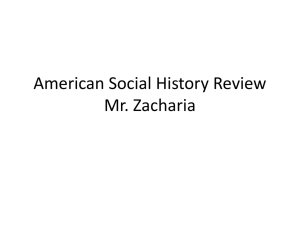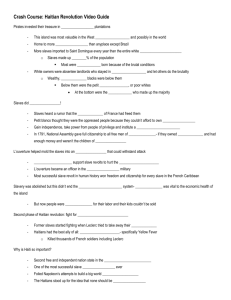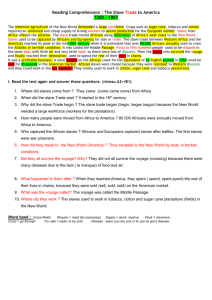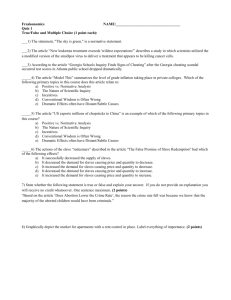APWH Mercantilism & Plantation Economies of the Carribean
advertisement
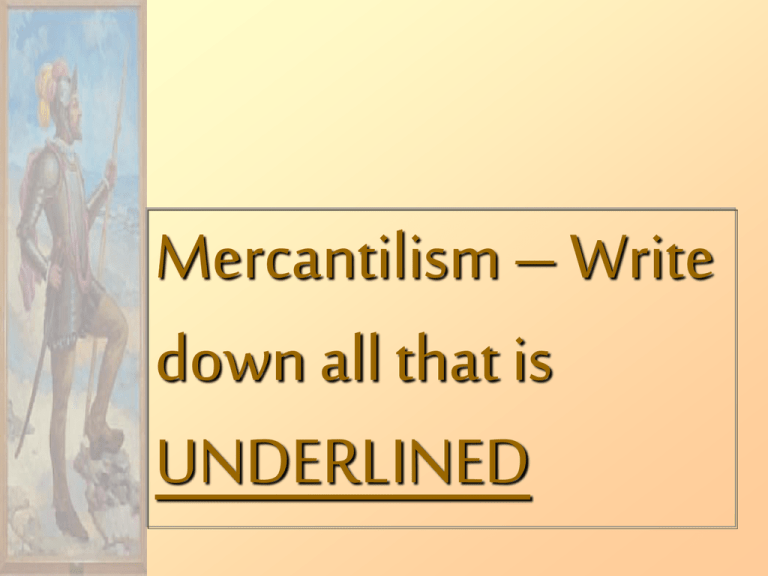
Mercantilism – Write down all that is UNDERLINED Characteristics of Mercantilism 1. “Bullionism” the eco. health of a nation could be measured by the amount of precious metal [gold or silver] which it possessed. – ‘Hard’ money was the source of prosperity, prestige, and strength for a nation. – Bullionism dictated a “favorable balance of trade.” • Export more than you import [a trade surplus]. High tariffs on imported manufactured good. Low tariffs on imported raw materials. 2. Each nation must try to achieve economic self-sufficiency. – Those founding new industries should be rewarded by the state. Characteristics of Mercantilism 3. Thriving agriculture should be carefully encouraged. – Less of need to import foods. – Prosperous farmers could provide a base for taxation. 4. Sea power was necessary to control foreign markets. – Less need to use the ships of other nations to carry your trade goods. – Your own fleet adds to the power and prestige of the nation. 5. Impose internal taxes of all kinds. Characteristics of Mercantilism 6. Colonies would provide captive markets for manufactured goods & sources of raw materials. (Write down Chart too!) Manufactured goods Mother Country Colony Raw materials Cheap labor 7. Trade is a “zero-sum” game. – A nation can gain in international trade only at the expense of other nations. Characteristics of Mercantilism 8. A large population was needed to provide a domestic labor force to people the colonies. 9. Luxury items should be avoided – They took money out of the economy unnecessarily. 10. State action was needed to regulate and enforce all of these economic policies. – State-sponsored trade monopolies. Who Benefited Most From Mercantilism? (Write this down) • Monarchs. • Merchant capitalists. • Joint-stock companies. • Government officials. Plantation Life in the W. Indies • Using your knowledge of the Spanish & Portuguese during the Age of Exploration, please compare and contrast both of the European countries in 3 distinct ways. Consider: exploration, conquest, slave trade, colonial system, labor systems, etc… Technology & Environment • Sugar plantations – Grew sugar cane and processed the cane into sugar crystals, molasses, and rum. – The technology was simple but dangerous – High expenses led to running large plantations • Environmental destruction – Sugar production caused: • soil exhaustion (repeated use of soil) • Deforestation – due to a desire to open new fields Technology & Environment (Cont.) • New food items introduced – European colonization led to the introduction of European and African plants and animals that crowded out indigenous species. – Colonization also pushed the indigenous peoples to extinction. – Africans introduced • Okra, black-eyed peas, yams, & mangoes. Slaves Lives Slaves Lives • Caribbean (W. Indies) society consisted of a wealthy land-owning plantocracy • A plantation had to extract as much labor as possible from its slaves • Slaves organized into work gangs • Slaves were rewarded for good work and punished harshly for failing to meet quotas • Sundays, slaves cultivated their own food crops – little rest and relaxation, no education, and little time or opportunity for family life. Slaves Working in a Brazilian Sugar Mill Slaves Lives (Cont.) • 4. Short Life Expectancy due to: – Disease – harsh working conditions – dangerous mill machinery – The high mortality rate added to the volume of the Atlantic slave trade • 5. Slaves frequently ran away and occasionally staged violent rebellions – Slave named Tacky in Jamaica – Europeans began curtailing African traditions, religions & languages
